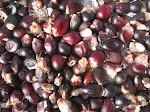
Our sister Beth came up from Mexico for Thanksgiving . . . with a beautiful dog she rescued from what she calls “the jail” – a un-shaded fenced area near Calexico, with over 300 dogs that had been rounded up.
This particular dog, a golden retriever-golden labrador mix, appeared to her in a dream . . . it’s a long story, but suffice to say that this is a special dog in need of a special home.
She is about 2 ½ years old, healthy and spayed, loyal and loving, playful and well-adapted to indoor living. She is also blind, but even Beth (a veterinarian) didn’t realize she was blind for quite some time because her senses of smell and hearing are so acute that she has no problems negotiating the world.
However, she does need a real home. The ideal home would be where she has a human companion with her most of the day -- a stable environment and a regular schedule. She does get along well with other dogs (after the initial introduction) and is even ok with cats. She will be fine in the city and is fine on a leash – in fact she seems to be more secure with the leash connecting her to someone she trusts. Once she has an olfactory map of her world, she doesn’t need any special help. She does have an extra need for intimacy and the security of having a person nearby. Her sense of connection and loyalty make her an excellent guard dog, as well as a loving companion.
If you think “Spirit” is the dog for you, or just want to find out a little more about her, call Beth before Dec 25 -- 309-965-2304.




